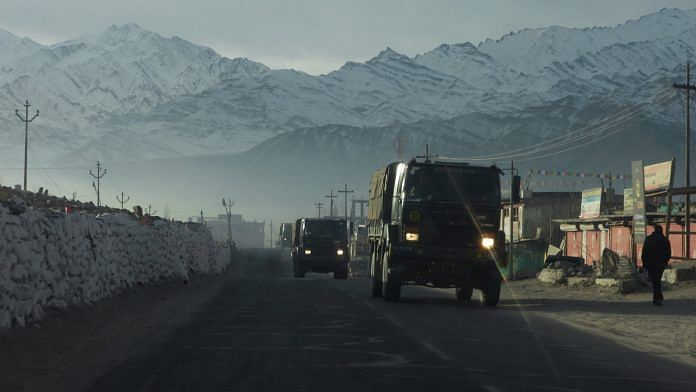New Delhi: Differences seem to have emerged between India and China over the next steps their armies need to take to further ease tension along the Line of Actual Control (LAC) in eastern Ladakh.
After the surprise breakthrough in February that saw both sides pulling troops and equipment back from the brink in Pangong Tso, Beijing wants the two armies to de-escalate or withdraw additional troops brought in as back-up to those in the front, ThePrint has learnt.
This is a change in Beijing’s position from what the two sides had discussed in February, it is learnt.
New Delhi, however, is insisting on disengagement from the remaining friction areas along the disputed Himalayan frontier first.
These were part of proposals exchanged between the two sides at the 11th round of Corps Commander level talks held last week, sources in the security establishment said.
De-escalation before disengagement could give China an advantage as it can move troops back to the frontline much faster than India due to the better infrastructure on its side of the Himalayan frontier, experts said.
The China Study Group, the sources said, will meet soon to take stock of the talks and discuss the proposal sent by China, and the Indian response. A key member of the group, Army chief Gen. M.M. Naravane, is currently in Bangladesh and is expected to return Tuesday.
This meeting could, however, be pushed to next week due the assembly election campaign in West Bengal and rising Covid cases. China will also discuss the proposal sent by India for disengagement at higher levels within their system.
Also Read: These are the key changes Army has made in Ladakh to counter China in summer
De-escalation or disengagement?
New Delhi and Beijing, the sources said, have agreed that further escalation of tensions is in nobody’s interest but there is a difference between the modalities of the steps to be taken next and the order of those steps.
India, they said, is insisting on disengagement because troops are facing each other off in at least four other locations. Last week, ThePrint had explained how China was dragging its feet on disengagement at other friction points, including what experts say are the low-hanging fruits of Gogra and Hot Springs.
A statement released by the Army after consultation with the Ministry of External Affairs following the talks last week said, “it was highlighted also that completion of disengagement in other areas would pave the way for two sides to consider de-escalation of forces and ensure full restoration of peace and tranquility and enable progress in bilateral relations”.
At the 10th round of Corps Commander level talks, held in February after the Pangong Tso disengagement, China and India had discussed the disengagement process and broadly agreed on some steps in the Gogra and Hot Springs area, the sources said.
However, China switched to talking about de-escalation in the 11th round.
Also Read: Disengagement in rest of eastern Ladakh will ‘take time’, but India ‘satisfied’ with China talks
Infrastructure advantage
While Army officers refused to discuss the issue saying that whatever had to be said had been mentioned in the Army press statement, a veteran explained that the Chinese have better infrastructure on their side and this would allow the PLA to move troops back to the frontline much faster than India.
Considering the low trust levels between the two sides, India wants to make sure that the disengagement happens first, which will then pave the way for de-escalation, the sources said.
The Army has already implemented a series of deployment changes in Ladakh for the summer and has also redrawn the Order of Battle (ORBAT) as one of the many steps planned to counter China.
Also Read: How India stood its ground and forced China to end Pangong Tso aggression




Always the same complaint of the mandarins having better infrastructure on the Tibetan side of the LAC, yet no hurry by netas to fast-track the build-up on this side, despite the fact that, with a 1.4 billion population, there’s no paucity of manpower or materiel on this side.
Yes i agree completely. DO NOT MAKE T GRAVE MISTAKE OF TRUSTING OUR SWORN ENEMY CHINA..
What is the difference between de-escalation and disengagement? If the troups are withdrawn into respective territories, I assume that they can be said to be disengaged. What is de-escalation? Is it withdrawal of artillery, tanks etc before the withdrawal of troubs. Unfortunately, this article does not explain the terms clearly.
Yes I too wd like to know its difference.
Does not sound logical or prudent. Even if the suggestion had come from a trustworthy friend.